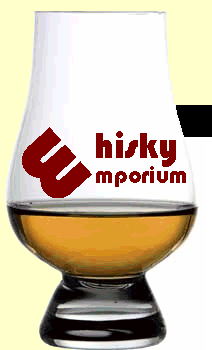|
Please
contact
me here to comment on any Dram-atics article, I'll include as
many replies as possible
|
| |
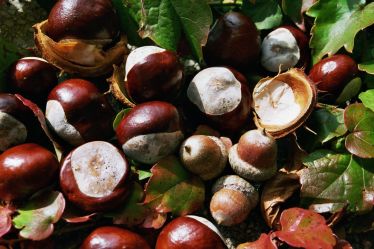 |
|
Autumn
2013
or
"Four years, going Maniacal and still no
updates?" |
|
|
|
| |
It's that time of
year again!
We've
just completed our annual Malt Maniacs' Filling Weekend where we
spend a whole weekend refilling entries for MMA from their
original bottles into our judges' sample bottles. The next
couple of days will see the mammouth task of packing and posting,
then things may go a little quiet during judging until the
results are announced in early December. But don't worry, I'm
planning a few (more) updates to Whisky Emporium during this
time, especially in the very near future with what I believe is
my first ever guest report. Yes, I'll be letting someone else do
the work around here with a report from the Autumn Speyside
Festival, but more of that later.
Of a little more
immediate importance it's birthday time!
I've
owned the Whisky-Emporium domain name for something like 7 years
now, but didn't really do much with it until almost exactly four
years ago when I had the idea to make it a home for my tasting
notes and whisky ramblings and it went live as such during early
October 2009. It has evolved much during those four years as my
original 100 tasting notes have now grown to over 1200. In fact
it sometimes seems like a full-time job keeping up with the
updates but I assure you it's a labour of love for me so I don't
plan to stop anytime soon.
Imagine my surprise
when
at Limburg this year I was chatting with someone at one of the
stands about their whisky and a few of my reviews and comments
about it, when the chap turned and introduced me to a certain
whisky book author who happened to be standing next to me; "Ahh,
you're Keith Wood of Whisky Emporium?" he asked, then continued
with "why haven't you updated your site in the last three years?"
I'm really not sure
where he was looking but
just in case he finds "Dram-atics" on Whisky-Emporium here's update No. somewhere around or just over 10,000; updates are
spread pretty evenly over the years so in the last four years
Whisky Emporium has enjoyed being updated with just over 1200
tasting notes but it's not so simple as each note requires an update to seven different pages, so here alone are 8400 updates.
Whisky Emporium has almost 200 pages and each one gets updated
with new copyright information annually, so let's say another
600 updates give or take a few allowing for some UK & DE pages
and steady growth over the last three years. Then we had the
introduction of this "Dram-atics" page in November 2009 and
since then there have been 33 different "Dram-atics" editions,
each comprising between 3 and 14 articles so let's say an
average of 6 which makes another 350-ish updates again allowing
for the English and some German versions. As I mentioned; Whisky
Emporium has evolved over the four years with various cosmetic
... ermm ... updates which again, allowing for the number of
pages on the site are incalculable but must number 600-700 if
not many more. At the moment I'm starting a series of code updates which will take me a good few weeks, maybe months as I
have to make some changes, sorry updates to every page. In
fairness will these be visible updates? Actually they will as
they will sort out a long-standing visual problem which I only
just recently discovered after changing my PC.
OK, enough is
enough, I'll leave it there. (Did we get to the 10,000 yet?)
Happy 4th Birthday
Whisky Emporium and here's to the next four!
|
|
| |
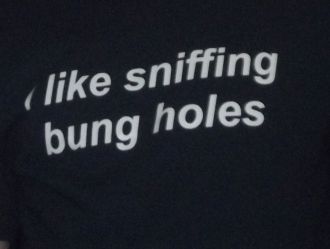 |
|
Speyside
Autumn
Festival 2013
The
Speyside Festivals (Spring & Autumn) are ones high on my 'to
visit' list but once again I failed miserably this year, so in
an attempt to put things right, albeit in a Dram-atics online
kind of way, I'm handing things over to someone who did attend
the Autumn Festival. In fact he's attended 25 Speyside Festivals
since Spring 2001 and for the first time ever, I'm handing
Dram-atics over to a guest reporter:
Some say he identifies whisky flavours with
those of Amazonian tree frogs, or that he's battled with
aardvarks in his wardrobe.
All I know is;
he's called The Bruce. |
|
| |
The chips were down on the way to Dufftown and so were the salt
and vinegar but not the sauce as that would have been a bit daft.
Perplexed by the plethora of condiments, the Autumn Speyside
Whisky festival was just what I needed and after many days of
great whisky, food, music, kiwi seductions, punchy one-liners,
jet-setting, sniggering and dodgy Euro-disco, here is my account
of it.
This report is not intended to be a definitive guide and may
contain factual errors, for which I apologize in advance. Tasting
notes are subjective and additional comment is added from
festivalgoers and experts present during note taking. To save
space, I refer the reader to previous reports and tastings if a
whisky re-appears and have also assumed the reader knows widely
available bottlings mentioned. Cask samples tasted are described
briefly, since they are not available for the reader to buy.
Finally, any water added was, literally, one drop and whiskies
were 40% abv, if the strength is not otherwise indicated.
Unfortunately, I had to take Thursday evening off, missing the
‘Mates of the Museum’ with its barrel-making contest and the ‘It
all started with a big dram’ event where Whisky Shop Dufftown
(WSD) owner Mike Lord celebrated being the first man to unicycle
across the English channel by warming up the festival with a taste
of Aberlour Bicentenary 12 year old, Glendronach Cask Strength
batch 2, his own exclusive bottling of Braes of Glenlivet and
Ardbeg Galileo which is the first in a series of releases that
will be followed by Ardbeg Figaro, Ardbeg Magnifico, Ardbeg
Scaramouche, Ardbeg Bismillah and will conclude with Ardbeg
‘Gordon’s Alive?’ but will not include Ardbeg Radio Gaga as that’s
just a bit much. |
|
| |
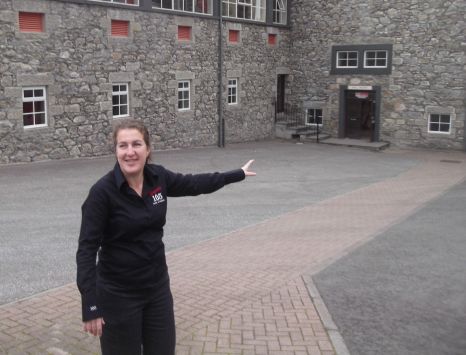 |
|
Glenfarclas distillery through the decades
Friday began with a special bus trip to
family-owned Glenfarclas where we would taste whisky from this
decade, working back through each decade until the 50s and Kate
would be our guide for the morning.
Glenfarclas was legally established in 1836
though a painting exists from 1791 showing the distillery name.
It was bought in 1865 by John Grant, who was looking for
farmland and managed, for the first five years by John Smith who
left to run Cragganmore distillery and was replaced by son
George Grant.
We tasted the 1997 ‘Family Cask’, at 58.8%,
described as a breakfast whisky, and I found it stylish, light,
crisp and creamy with a playful bite on the finish, making it a
whisky unsuitable for Luis Suarez. |
|
| |
Interestingly, the nearby
Ballindalloch castle estate owned the land until 1930 and then,
having sold it, cut off the water supply immediately afterward.
The resulting legal case was taken to the House of Lords and the
water was given to the distillery in perpetuity. A minimum of
100,000 litres are used every day.
On-site malting ceased in 1972 and some 330
tons, 2 weeks supply, can be stored on site. 16.5 tons, peated
to 3ppm, are used per mash and the distillery uses a Bueller
mill, from Switzerland, as opposed to the more common Porteus
mill made in Yorkshire. The wash backs are stainless steel and
Kate noted that the beginning of the process is modern but gets
less so as the process goes on. Fermentation takes 52 hours.
Heading round, we saw the bottom of a still being replaced but
not the neck, a consequence of the stills being direct-fired.
Direct firing is noisy, expensive and more energy-intensive than
steam heating and the stills have ‘rummagers’ to stop sticking
which results in wear and tear on the copper. The distillery had
briefly used steam coils but this had made the new-make spirit
unrecognizable as Glenfarclas.
Heading to the
warehouse, we tried a 2010 cask sample that smelled of
toffee-fudge ice cream and tasted of fruit crumble with only the
finish betraying its youth. By contrast, a 2000 cask sample from
a 2nd or 3rd fill cask had Kate declaring
that she could detect the taste of ‘Sugar Puff’ cereal. Allowing
the sample to breath changed it a lot and I tasted toffee sauce
and a hint of smoke.
The warehouse
at Glenfarclas has been constructed to ensure that the
temperature does not deviate by more than 6 degrees as opposed
to 40 degrees outside and, apparently, the temperature itself is
not as important as the lack of change. Some 55,000 casks are
maturing, dating from 1953 to the present day. The distillery
does not do ‘finishes’ or ‘re-racks’ but does occasionally fully
mature whisky in Port or Cognac casks. Sherry casks are sourced
from a family-owned business in Spain. First-fill bourbon casks
are never used for maturation but refill bourbon casks are.
Some spirit is sold for blending
and is prohibited from being bottled as Glenfarclas since the
distillery has had nothing to do with the maturation. Recent
casks have been filled at 68% and this will ensure sufficient
stocks for the popular 105 bottling.
|
|
| |
The ‘Family Cask’ series was launched
in 2006 and ranged from 1952 to 1994 and it is apparently very
rare for a distillery to have good stocks from consecutive
years.
Working back through the years, we had a 1985
vintage, at 44.9%, bottled in 2012. Andy Ellis got citrus and
orange notes while I detected blackcurrant ‘Fruitella’ sweets,
noting that it would go nicely with a chocolate orange sweet. A
1976 vintage, bottled in 2007 at 49.4% had the aromas of a Fry’s
orange cream with a delicate taste and spicy finish.
A 1965, bottled in 2012 at 51.8%, had an
orangey nose while Andy Ellis remarked on its tannic grip before
we ended with a 1957, from a first fill hogshead. Bottled in
2012 at 43.7%, it smelled of soft leather and a little orange
with a very peppery taste and some very dark chocolate that gave
way to ash at the end. (Finally, I must mention that the current
105 is so smooth that a pub measure of it can be drunk neat.)
|
|
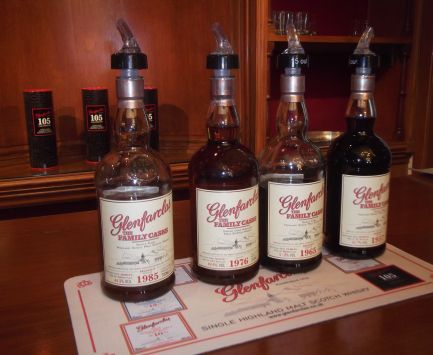 |
|
| |
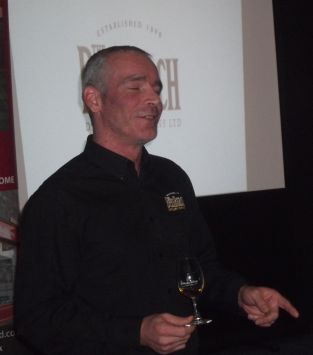 |
|
Benriach, Glendronach and Glenglassaugh with
Stewart Buchanan
After being introduced by Mike Lord, the man
who ate 5 sharks in a feeding frenzy, Stewart Buchanan opened
with his favourite, Benriach 16, which he describes as a
‘classic Speyside expression’. He then discussed the
composition of the bottling, something that is described at
length in the May 2011 report.
Casks have become more expensive and this has
meant that the number and volume of ‘finished’ releases has been
scaled back. Benriach was fortunate in the respect that previous
owners Chivas had never owned a west coast whisky so experiments
were carried out with peated barley and the serendipitous
results are still with us. A 1983 single cask release, at 43.9%,
is notable because very little whisky was produced at Benriach
during that crisis year for the industry. The nose was very soft
with chewy tropical fruits with spice and peppery flavours
erupting from it with a drop of water. Stewart found this to
have a lovely bite. |
|
| |
The 17 year old ‘Septendecim’
smelled like Bowmore, confirming my view that Benriach is the
most Islay-like of any peaty Speysider. It had some chewy peat
and saltiness with water revealing elegance and spice that gave
way to a long, warm and peppery finish.
Moving on to Glendronach;
we had the 15 year old ‘Revival’, at 46%, which is reviewed in
the autumn 2010 report. Slightly leathery and with a robust,
chewy finish, this is the distillery’s biggest worldwide seller
Next up was the 21 year old ‘Parliament’, at 48%abv, covered in
the autumn 2012 report and still the last word in luxury.
Stewart believes that the relatively high strength is needed to
preserve the character of the sherry casks used in maturation
and a lower strength would destroy this character.
A 1994 Oloroso single cask, at 58.4%, had
subtle, sweet softness with characteristic sherry cask notes to
taste. The finish was long, sweet and charming and benefits from
time to breathe and develop in the glass to become a fine
digestif. Stewart said that he thinks it makes your hair stand
on end but I told him that I would make the bald jokes, thank
you very much, and there was no need to bristle about it.
Glendronach has made a limited run of peated
spirit and some quarter casks of unpeated spirit have been there
for 6 years, meaning they will probably be released next year.
Batch 1 of Glendronach cask strength was released in October
2012 and sold out by Christmas. Batch 2, at 55.2%, has now
virtually sold out and batch 3 is in progress. Batch 2 is
composed of 80% oloroso matured whisky from 1993, 94 and 95 plus
20% Pedro Ximenez (PX) from 2002 meaning that it could be called
a 10 year old though this would be underselling it. I found it
very chocolaty and crisp with orange notes the reader is
recommended to take a large mouthful and roll it around on the
tongue. Stewart described it as the ’15 year old on steroids’
and, again, the reader is invited to buy this and the 15 year
old to compare and contrast.
We closed with Benriach’s release of
Glenglassaugh 30 year old, at 44.8%, taken from 3 refill sherry
casks. Delicate and velvety with sweet fruits, syrup and
raspberry ripple, this was another luxurious dram. Stewart
finds that Glenglassaugh has both Highland and Speyside
characteristics and noted that the Benriach Company has invested
heavily in their newly acquired distillery to improve the site.
|
|
| |
Berry Brothers and Rudd Tasting with Jonny
McMillan
With a quickfire delivery to rival that of
Tim Vine, Jonny McMillan of the Great Whisky Company,
distributors for Berry Brothers and Rudd (BBR), presented a
series of unchilfiltered bottlings. The first five of these were
taken from refill hogsheads. Using PowerPoint software, Jonny
compared single casks to distillery releases with a suitably
pixilated bottle of a well-known island malt with its name but
not the distinctive bottle shape obscured. Further comparisons
were made between a sirloin steak and a horse burger with added
Shergar (part of a stable diet) and between Led Zeppelin and One
Direction to much audience laughter. |
|
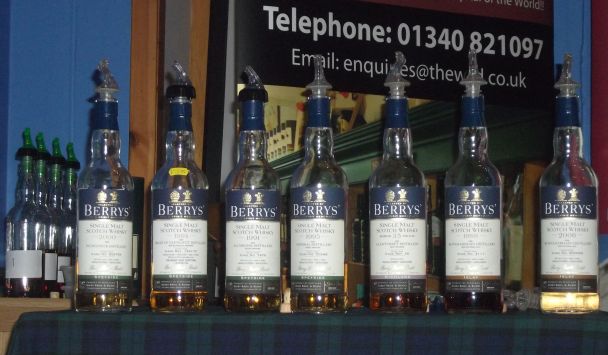 |
|
| |
Rolling his glass, which he says makes it
appear you know what you’re doing; his first whisky was a 2000
Inchgower, at 46%, and described as a ‘classic bourbon cask
Speysider’. It smelled of sherbet and refresher sweets and had
a chewy, vanilla taste that became very sweet with a drop of
water.
Describing BBR’s Doug McIvor as having a
sense of humour so dry, it has evaporated, Jonny moved on to the
WSD exclusive bottling 1994 Braes of Glenlivet, at 53.9%. This
had aniseed on the nose with the taste being light and sweet
with fruit syrup, refreshers and vanilla. Interestingly, BBR now
own Glenrothes distillery, having swapped the Edrington group
for it with the Cutty Sark blend.
A 1991 Auchroisk, at 54.6%, had a fresh,
light, grassy, floral nose with hints of vanilla. This had great
mouthfeel, required by Doug McIvor from his whiskies and he does
not use first fill casks, believing that refill casks
demonstrate a distillery’s character.
By this stage, Jonny was in full flow and
aided by a willing audience member who obligingly walked into
all of his jokes. Even better, while presenting a 1995 Imperial,
at 46%, Jonny asked why the distillery was so called and Danny
Maguire, the man who studies for his blood tests and who has
vowed to never again iron his underpants while still wearing
them, answered. BBR have received two royal warrants and Jonny
showed us some pictures of royal family members with bottles of
BBR whisky that may or may not have been altered with Photoshop.
The Imperial was creamy and had notable shortbread flavours that
cried out for some of Walkers finest. The finish was creamy and
peppery. A 1977 Glenturret, at 46%, had fruit salad chew bars
and tropical fruits on the nose while Andy Ellis found it waxy.
Jonny recommends chewing this one for about 10 seconds and there
was a cornucopia of fruit, wax and spice with a long, sweet
finish.
A 1988 Bunnahabhain, at 49.8%, from a refill
sherry butt, had Bovril, treacle and dark chocolate notes while
Jonny gets struck matches from it. Jonny told us how he was once
cautioned by the police over a linguistic misunderstanding he
had with an American who thought that what Jonny described as a
piece was a firearm, rather than a Scots term for a sandwich. A
2006 peated Bunnahabhain, at 46% and originally made from
blending, smelled of smoked ham to me and smoked cheese to Andy
Ellis while it tasted both minty and chewy with some slight
peat.
|
|
| |
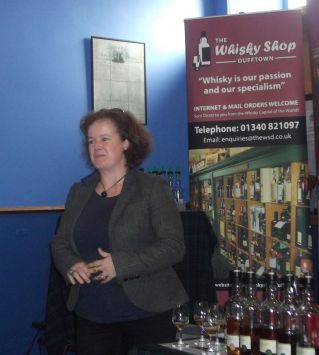 |
|
Adelphi Tasting with Antonia Bruce
Antonia began with 2001 ‘Slaney’, a mystery Irish whiskey, at
57%, which was distilled twice. Archibald Walker, owner of the
Adelphi distillery in Glasgow, owned Limerick distillery in
Ireland and this is part of the new ‘Limerick’ range. Taken from
a refill bourbon cask, I found the taste of lemon cheesecake
while Antonia got sherbet lemons and Madeira cake. The finish
was long with both syrup and bourbon flavours.
Handily, a text came in, telling us that the Ardnamurchan
distillery is due to be complete in January 2014 and production
is planned for next year. A 1990 Macallan, at 56%, from a refill
sherry hogshead had McCowan’s toffee, Butterkist popcorn and
orange peel aromas with the taste of raisins, burnt toast,
coffee and toffee and dark chocolate to finish. Antonia reckons
this is a classic Macallan. |
|
| |
2006 Glenrothes, at 67.2%, led to speculation about the filling
strength of the cask and there were hints of Bovril about the
nose before water opened up fudge and toffee notes. It tasted of
rich and velvety wedding cake, prompting Antonia to ask for food
pairing suggestions so I recommended sticky toffee pudding
though I would have done that if I had been drinking Irn Bru as
I’m a bit biased. 1994 Tobermory, at 58.8%, from a first fill
sherry butt was found smell musty and of prunes, brandy and salt
by both Antonia and Andy Ellis. It had sherry, seaweed and salty
tastes with Andy finding onions and meat juices.
We ended with a 1996 Bowmore, at 52.5%, which had been matured
in a Spanish hogshead. There was characteristic toffee and mints
on the nose. There was a little smoke on both the nose and
subtle peat and sherry notes. Andy, not a fan of Bowmore,
reckoned this whisky had great balance. As we closed, Mike
thanked Antonia for taking time off from laying bricks at the
distillery. |
|
| |
Carn Mor Scottish Liqueur Centre Whiskies; Peter Mackay
In quick-fire mode himself, Peter began with the blended malt
‘Old Perth’, at 43%, and a potted history of blending in the
city. The Old Perth brand began as a blend 100 years ago but
later changed its name to Beneagles. Carn Mor relaunched it this
year as a blended malt, containing mostly Aultmore, Mortlach,
1996 Ben Nevis and 1987 Tomatin. Soft, dry and creamy with some
vanilla and slight smoke to end. This blend has been described,
by a German writer, as a ‘good TV whisky’, something Peter told
us in a German accent as accurate as Tim Vine’s Dale Winton
voice.
A 1989 ‘Celebration of the Cask’ Bunnahabhain, from a bourbon
hogshead, at 43.5% was delightfully creamy and silky with notes
of vanilla while Peter got banana from it. |
|
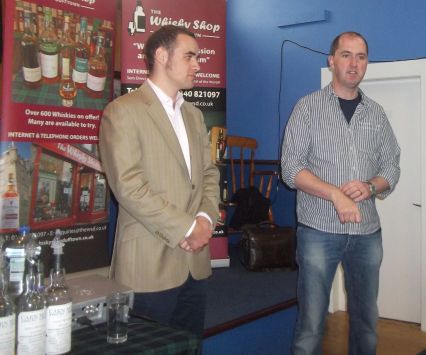 |
|
| |
A 1994 Blair Athol, at a standard strength of 46%, was the first
of 4 ‘Strictly Limited’ (SL) bottles, all of which would make
excellent session drams. It was taken from 2 hogsheads that had
been vatted into a sherry cask for the final 3 weeks of
maturation, making it not so much as a finish as a tickle.
Although hard to pick out flavours, I found it marvelously chewy
with a very slight sherry character and, moreish.
A 1998 Auchroisk had also had 3-4 weeks in a sherry cask and
retained a nutty and grassy nose. It also was chewy with vanilla
and nuts and fruit. A 1999 Dailuaine had cereal maltiness on
both the nose and taste with maltiness again at the finish with
some slight pepper also.
1995 Mortlach was taken from 2 casks and Peter believes that the
distillery makes the heaviest and richest spirit in Diageo’s
portfolio. The nose had apple crumble and caramel while the
taste was grassy, floral and malty. The finish was creamy and
peppery. A cheery bonus dram arrived in the form of a sister
cask to the earlier 1989 Bunnahabhain that may be released as a
WSD exclusive in the future.
Tannochbrae Gala Dinner with Robin Laing and Antonia Bruce
Few things can beat dinner at the Tannochbrae restaurant with
music and poetry from bard Robin Laing and more Adelphi whiskies
presented by Antonia. A refreshing ‘Italian Monkey’ cocktail,
made with ‘Monkey Shoulder’, began the evening, leading Robin to
sing ‘Monkey Shoulder’. Our first whisky was a 1992 Longmorn, at
52.1%, from a sherry cask that imbued it with the soft taste of
brandy butter. A 1987 Mortlach, at 59.4%, from a refill bourbon
cask had a rich bourbon nose and water revealed the taste of
cherries, pears and almonds. Dessert began with some delicious
Adelphi Fascadale ice cream, available from Dufftown’s Balvenie
Street ice cream shop and our final dram was 1986 Glen Moray, at
56.8%, that smelled of sharp, crisp vanilla and was creamy,
spicy and peppery with a soft, bourbon-like finish.
We also tasted the Slaney whisky from earlier again, which led
Robin to sing the Irish tune ‘Whisky, you’re the devil’. New
track ‘Whisky Men’ had been slightly rewritten to include a
verse about whisky girls and Robin also sang ‘The wee cooper of
Fife’, ‘Whisky for Breakfast’ and ‘Tall tale’.
|
|
| |
|
Train to Keith for the Strathisla ‘Straight
from the cask’ tour
On Sunday morning, I took the journey from
Dufftown train station to Keith. The line was closed decades ago
but has been brought back to life by volunteers who work
weekends and the train passes by the closed Parkmore distillery
and the site of the former Towiemore distillery that now makes
stainless steel containers for the food and drinks industry. (A
café is sited at the station.)
Arriving at Strathisla distillery, Tony was
our expert guide for the limited edition ‘Straight from the
cask’ tour. Many of the whiskies featured on this tour had sold
out in the Chivas Brothers distillery shops at Aberlour,
Strathisla and Glenlivet or sold out over the course of the
weekend so notes are brief.
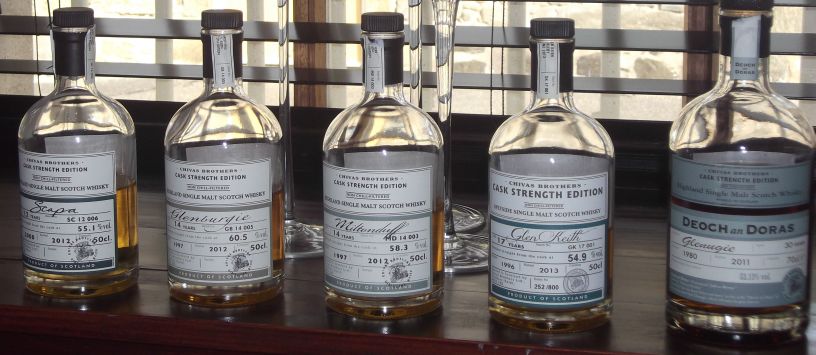
Most of Strathisla’s details are covered in
the spring 2012 report but it is worth noting that the
distillery uses spring barley as winter barley doesn’t have the
correct properties for whisky. Also, it had been named Milltown
distillery between 1786 and 1951 though the whisky it made was
always called Strathisla.
Tony told us of the financial shenanigans of
a previous owner called James Pomeroy who ended up in prison and
the distillery was 110,000 pounds in debt when Canadians
Seagram’s bought it over.
Strathisla can make 2.4
million litres per year, 10% of which is bottled as single malt.
Casks are filled at Glen Keith distillery next door which is now
back in production. Heading to the old filling station at the
distillery, we tasted the now sold out 1997 Strathisla
‘Distillery Edition’ (DE), at 58.7% which had a floral and minty
nose that blossomed with water to reveal fruit loaf and spices.
The DE series is released in batches of 800 bottles, which are
numbered and, heading to the tasting room, we tasted 2000 Scapa,
at 55.1%, which sold out at the distillery during our visit.
Matured in fill bourbon casks, it had banana chew bar notes with
butterscotch and water revealed some maritime character and a
dry, long and salty finish.
1997 Glenburgie, at 60.5%abv,
is still available at the time of writing and water opened the
whisky to reveal honey and bourbon. Again matured in first fill
bourbon casks, this was soft with citrus fruits and lemon zest
notes albeit with a short finish. Glenburgie distillery is the
third largest of the Chivas portfolio, at 4.2 million litres
capacity and the second biggest is Miltonduff, at 5.2 million
litres. 1997 Miltonduff, at 58.3%, had vanilla and orange zest
aromas with Edinburgh rock and bourbon flavours. A drop of water
gave it a much bigger punch though the finish was very soft with
some rich vanilla.
I found it fascinating to discover that the
distilleries historically associated with the Ballantines blends
– Scapa, Glenburgie and Miltonduff – still have most of their
product used for that blend while the Chivas distilleries – Glen
Keith, Glenlivet, Longmorn and Strathisla – still go mostly to
the Chivas blends.
1996 Glen Keith was bottled at 54.9% to mark
the reopening of the distillery in June. (Glen Keith was built
in 1958 and closed in 1999). It smelled of banana and custard
yoghurt with orange notes also present. It had a honey and
bourbon taste with an elegant and subtle bite to end with.
We closed the tasting with a bonus dram of
1980 Glenugie, bottled at 52.1% as part of the ‘Deoch an Doras’
series, taken from demolished distilleries. Covered in detail in
Spring 2012, this is still highly recommended to the reader and,
anyone able to obtain a bottle from the series is to be
congratulated.
|
|
|
| |
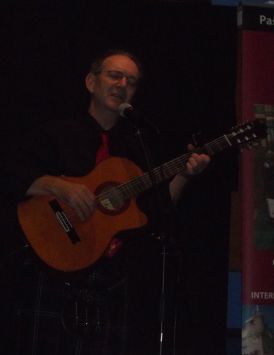 |
|
Music with Robin Laing – the whisky bard
As Sunday evening approached, the chips were yet again down and
this time with a fried Mars bar and only a warm, flat bottle of
Strike Cola to go with it. However, good taste was at hand as
Robin Laing played a varied set list with songs about whisky and
not about whisky while presenting these whiskies:
Cooper’s Choice 1998 Clynelish, at 46%, that tasted of syrup,
golden honey, vanilla and cream.
20 year old Berry Brother’s Caperdonich, at 46%, that was soft,
grassy, delicate and peppery.
|
|
| |
Benriach 15, at 46%, Tawny Port finish was awesome with rich
orange and milk chocolate aromas and chocolate again on the
taste with subtle hints of port.
Dalmore Spey
was soft and velvety and Neil Simpson reckoned it had a peppery
kick to finish with.
1994 Glendronach, at 55.1%, smelled of Bovril and treacle so
thick you could dance on the top of it with a silky smooth and
surprisingly light taste that faded only slowly at the end.
The widely available Old Ballantruan, at 50%, has a bigger peat
punch than in previous years.
As always, the whiskies are secondary at a Robin Laing gig and
the tracks played included ‘Born in the wrong time’, ‘Forth
Bridge Song’, ‘Black Clothes’, ‘Black Coffee’, ‘Jamie Penman’,
‘Punters’ and ‘Guernica’. Picasso’s painting of the same name
inspired the latter song and Robin believes that he was a
Scotsman whose real name was MacAsso. Returning after an
interlude, he played ‘Black Art’, ‘Bruichladdich Dram’, ‘Queer
folk in the Shaws, ‘Whisky Men’, ‘Speyside Whisky Song’ and many
others including the ‘Missionary Song’ which prompted him to
tell us that there is African whisky out there and he hopes it
remains out there. Also, the second edition of his book ‘The
Whisky River’ is now available.
As usual, highlights from Robin’s
performance are available on both Facebook and
www.youtube.com.
Glen Ord Distillery Tour
Taking a detour to the highlands, I headed to Glen Ord
distillery, in Ross-shire. Raymond, the guide, gave the party an
abbreviated tour as the distillery is currently doubling in size
from its current 5 million-litre capacity. Glen Ord has a
hugely impressive visitor’s centre that is very pleasing to the
eye. The on-site maltings produces malt for Talisker, Clynelish,
Teaninich, Cragganmore and many others.
12.5 tons of grist are used per mash and the wash backs are 25
feet tall. A fermentation of 75 hours has been found to give the
spirit a dried fruit and orange peel character while; by
contrast, a 48-hour fermentation gives nuttiness. There are 6
tall stills with very long necks and 8 warehouses are on-site
that house the spirit of Glen Ord and many other distilleries.
The current ‘Singleton’ of Glen Ord 12 year old release has a
50:50 ratio of sherry to bourbon casks and these are married
together for a month in stainless steel. 70% of the whisky made
is bottled as single malt while the remainder goes to the mighty
Johnnie Walker blends. The previous release of Glen Ord, not
known as the ‘Singleton’, was 70% sherry and 30% bourbon. Off
the ‘Singleton’ series, Dufftown is sold in Europe, Glendullan
is sold in North America and Glen Ord is sold to South East Asia
where demand far exceeds supply. As it is, the distillery is the
only place in Britain where any ‘Singleton of Glen Ord’ is
available to buy.
The ‘tasting experience’ tour ended with a tasting conducted by
the knowledgeable Gordon Sinclair. This tour offers the chance
to taste 3 whiskies from owners Diageo’s vast portfolio. The
widely available Dalwhinnie 15, at 43%, is still a tremendously
easy drinking whisky and Gordon recommends freezing it and
serving it straight. The current 12 year old from Glen Ord is
also tremendously easy to drink with a velvety smoothness to it.
Interestingly, Gordon told us of a production mistake in the
past where hot water was wrongly injected into the cooling
process and that gave the spirit much more sweetness so it has
been left in place. A bonus dram of the 15 year old, at 43%,
was slightly fuller and richer than the 12 year old. (An 18 year
old is also available at the distillery).
The popular Talisker 10 year old, at 45.8%, was on form with an
entertaining big punch to the taste buds and characteristic
smokiness present. One final note is that Diageo, in the past,
received a large order for unpeated Caol Ila that was cancelled
at the last moment. Undeterred, the company pressed on and
released some of it any way. Currently available from their
special releases range is a cask strength, unpeated Caol Ila
that has been matured in sherry casks and curious readers are
invited to taste it.
Cadenhead’s Creations and beyond with Mark Watt
Arriving back from Japan was Cadenhead’s Mark Watt who, after
recovering in the Royal Oak, presented some of his recent
‘Creations’ range, amongst others. (Mark got married in the
summer and, appropriately, the cake was half-cut.) Mark said
that we were drinking 127 years of whisky and that is not as old
as the jokes of Danny Maguire, the man who recently ran a bath
and came in fifth, his best performance to date.
An 18 year old ‘Creations‘ Glenrothes-Glenlivet, at 46%, was so
named because the company had always called it that. According
to Mark, tradition is a good thing unless it’s a bad tradition.
This whisky had vanilla and creaminess on both the nose and
taste. A drop of water revealed the taste of light golden honey
and Mark believes this to be a dangerous whisky as it would be
easy to drink a bottle of this. He also describes it as a ‘good
report-writing whisky’; something that almost, but not quite,
made me bristle.
A 21 year old Glengarioch, at 53.7%, led Mark to note that
distillery has a one-word name though the brand has a two-word
name. This had the taste of rich, golden honey and a slight
peatiness lurked in the background. Danny Maguire found stewed
apple, demonstrating there is nothing wrong with his palate even
though he has 4 cauliflower ears from 20 years in the Austrian
navy and a lifetime of playing chess.
A 24 year old ‘Small Batch’ Cragganmore-Glenlivet, at 57.5%, was
made at ‘one of forty distilleries older than Cadenhead’s’. Both
the nose and taste had peaches, golden syrup, cream and sponge
cake while the finish had a slight smokiness and was very long.
Pausing to recount the history of his company, Mark noted that
previous company owners, including Mr Cadenhead, Mr Duthie and
current owner Hedley Wright, have never had heirs to leave the
firm to. When he departs, Mr Wright will leave Cadenhead’s to
the town of Campbeltown. Springbank distillery bought
Cadenhead’s to put their bottling line to use and a new line is
currently being built as they couldn’t find one to work slow
enough – the fastest produced bottling line would bottle a
year’s production of Springbank in one month. Current bottling
ranges are now available in 23 markets worldwide, having
previously only been sold in the company’s own shops, of which
there are 8.
A 1979 Dufftown sample was a year older than Mark Watt is and
one audience member reckoned it was a lot more mature. Mark
found it beefy, describing it as a beast of a dram and reckons
there will be about 140 bottles released, depending on how many
tastings he does. Detailing his and the company’s modus
operandi, Mark asked the legitimate question ‘when did you last
lick packaging?’ pointing out that Cadenhead’s don’t spend a lot
of money on packaging, thus keeping the price down. He was also
promoted and given a raise before he had sold a bottle.
Expecting half or quarter bottles, he was asked by veteran Frank
McHardy whether he would like half or full bottles to sample and
still doesn’t know why he said half.
Moving on to a 21 year old Cooley Irish Whiskey, at 56.3%, Mark
began to talk about the distillery being next door to the more
famous Bushmills, thus bucking the trend among whisky brand
ambassadors by having James May’s sense of direction rather than
his taste in jackets. Thus corrected, Mark recalled the time he
found Green Spot pure pot still whiskey in a bar and ended up
sweating Green Spot. The following day, he was ironically handed
a glass of Green Spot and asked to identify it. This whiskey was
soft and delicate with bananas and tropical fruits with many
audience members finding peat, something I didn’t get.
Sitting beside me, Neil Simpson found a 2003 Bowmore cask sample
to be mellow with pickle and almonds while I detected the smell
of Murray Mints. This had apparently been rubbish before
finishing but had been re-racked into a cask that had previously
held Longrow whisky to give a fine whisky. Cadenhead’s will not
do a finish if it is less than 3 years and Mark also says that
he doesn’t want to walk into a bar and not buy his own whisky,
as it’s too expensive.
Asking the rhetorical question ‘Can you tell if a whisky is at
its best?’ he answered that it can only be answered definitively
after it has peaked and you find yourself saying that it would
have been so much better last year.
As the tasting ended and the stories flowed, Mark told us that
he has taken to winding up a Diageo brand ambassador whose name
I will withhold by singing the company’s name to him to the tune
of ‘D-I-S-C-O’.
The festival ended with Mike announcing at the drams party that
newcomer Hankey Bannister Heritage, at 46%, had soundly defeated
the illustrious Johnnie Walker’s Platinum, last year’s winner,
to win the ‘blind blends’ competition while Glendronach 12 had
won the contest to see which whisky best accompanied haggis and
Tomintoul 16 received 100% of the vote, saying it went best with
a bacon roll and then those attending the party kept the dodgy
Euro-disco theme going as the night wore on.
To end, I’d like to thank those involved in organizing and
running the festival and, in particular, Mike Lord, Val and the
crew Vicky, Kirsteen, Gemma, Warren, Jen, Simon and Kat, to
Alan, James and the crew at the Tannochbrae, the Dufftown to
Keith railway volunteers, the Coffee Pot and the Stuart Arms and
to Claus and Claire for the proofreading.
I’m off to read ‘Armadillos in your sock drawer’ by Jeffrey
Porbeagle-shark, and I’ll see you at the spring festival when
the chips will be down again, this time with 2 sausages and a
bottle of Irn Bru.
|
|
| |
 |
|
I first met Bruce
Crichton some years ago whilst sitting in a Highland Park
masterclass in George Sq. Glasgow, listening to their new brand
ambassador Gerry Tosh waxing lyrical about the new
medicine-style bottle shape and the 'glug glug factor'.
Bruce is
an enthusiastic amateur in the whisky world and attends numerous
whisky festivals in Scotland. He reads and writes on the subject
of whisky sporadically and often travels under the pseudonym 'Moist
Von Lipwig'. His favourite word in the English language is 'perplexed'
and his favourite whiskies are the ones that taste mostly of
Scotch.
Thanks for the report Bruce. |
|
© Copyright
2009-2013 by Keith Wood - All rights reserved - Whisky-Emporium |
 |
